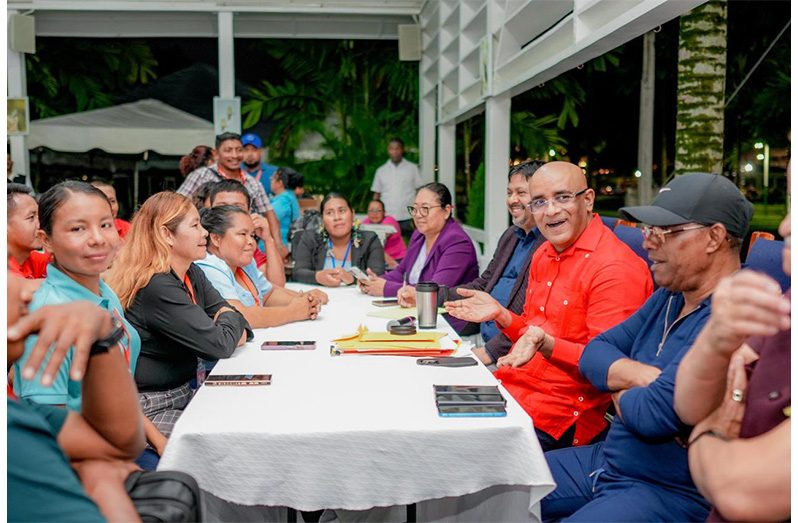–highlights how the indigenous people have lauded the PPP/C’s track record of development
General Secretary of the People’s Progressive Party (PPP), Dr. Bharrat Jagdeo has called out sections of the media for their “deliberate distortion” of the recently concluded National Toshaos Conference (NTC) and the government’s engagement with Indigenous communities.
During a press conference on Thursday last at Freedom House, Georgetown, Dr. Jagdeo dismissed a report in the Stabroek News, which he said attempted to paint the picture that the indigenous people are being neglected under the ruling PPP/C administration.
“So again, the Stabroek News predictably tried to characterise the NTC as, and the Toshaos and the Amerindians as suffering under the People’s Progressive Party/Civic period in office,” the General Secretary, who also serves as Guyana’s Vice President, said.
“So it was, it’s just a negative portrayal of everything and a distortion, a total distortion,” he further stated.
The Vice President, while rejecting the narrative, highlighted the overwhelming sentiments expressed by the Indigenous leaders during the conference.
The Vice President said, “Almost every Toshao from every area would start off by saying, we thank you for all the progress. This is not PPP telling them to do that, because they could have done it under APNU, too… In my interactions with them, I had to say, ‘thank you very much for saying all these good things about the PPP, but can we get on to the problems?’
“Because if every one of you will list the list of achievements that you have had in your communities, the roads and the schools and the health centres and the playground and all of that, livelihood issues and the support of the government, then we’ll never end the conference and I’m here more to look at problems.”
Dr. Jagdeo further highlighted that numerous Toshaos even voiced their unsolicited support for the PPP/C government, crediting them for the transformative development taking place within their villages.
The Vice President emphasised that the government was not focused on what they have done but what more they can do for the people of this country. However, he did note the sensationalising by critics of the high freight costs, without even providing context.
Dr. Jagdeo said: “So, they go and pick up one issue like the cost-of-living issue, the cost of freight. And yes, freight prices are high, but they don’t say that to APNU on the high freight prices [which] had value added tax that we removed. But flying things into the hinterland will have a cost because of the airline. And we made it clear we’re going to address this. And if we can’t address it through cutting the margins of the middlemen, who are now making most of the money from what the airline people told us, then we’re going to do it through a commercial arm of the GDF to fly things into some communities where we can cut the cost of freight for the hinterland.”
Also, the Vice President pointed to the range of initiatives already benefiting citizens and noted that the government is aiming to expand them even further.
“Because the indigenous communities, some will benefit from cheaper electricity now and free electricity, but not all have like what we have on the coast. So subsidised electricity, subsidised water, subsidised gasoline and diesel, most of it. Well, that would affect everyone on the Coast to keep the cost of living down, lower mortgage rates, and stuff like that. Because that’s what the government has done on the coast to address the cost of issues.”
TRANSFORMATION
Dr. Jagdeo, during a previous news conference, pointed to key achievements, such as increased employment, infrastructure improvements, and land titling. The previous government, he noted, spent $5.8 billion on capital projects across four regions over a five-year period.
In contrast, the PPP/C government, according to Dr. Jagdeo, invested $6.5 billion in a single initiative: the cash-grant distribution programme. This amount, he emphasised, surpassed what the previous administration spent on key infrastructural development in hinterland communities.
“That’s the magnitude of the difference. We spend on capital now; we spend in a single year more than what they have spent in the five years in some of the regions,” he said.
Further, he said the government is currently constructing four secondary schools in the hinterland areas, including places like Kwebana, Hosororo, and Karassabai. The combined investment in just these four schools surpasses the total capital budget allocated across all sectors over the past five years.
That, according to Dr. Jagdeo, gives a sense of the scale of development happening in these regions. And that’s not even considering other infrastructure, such as the roadworks in communities like Maburuma Settlement leading to Hosororo, or development in the Moruca area and beyond.
This level of investment reflects a strong commitment to accountability and highlights the scale of our efforts. In addition to this, $1.5 billion is being invested in housing. Approximately $32 billion has been invested through the Ministry of Amerindian Affairs alone, excluding spending on health and education.
This funding was channelled through initiatives such as the Amerindian Development Fund, the presidential grant, and support programmes for youth and women’s development in these communities. This figure does not include the additional infrastructure work, such as roads already completed in these areas.
The Hinterland Scholarship Programme by itself accounted for over $400 million. He further pointed to a key initiative that exists today because of the innovation and leadership of the PPP government: The Low Carbon Development Strategy 2030 (LCDS 2030).
Over the past three years, Amerindian communities have received substantial funding through this programme, US$22.7 million (or G$4.7 billion) in the first year, US$23.27 million (around G$4.8 billion) in the second year, and another US$22.7 million (about G$4.73 billion) this year.
Altogether, this adds up to more than $14 billion in support, enabling these communities to carry out nearly 4,000 projects aimed at local development.



.jpg)








